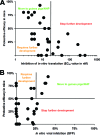Chemical modifications of antisense morpholino oligomers enhance their efficacy against Ebola virus infection
- PMID: 19223614
- PMCID: PMC2681561
- DOI: 10.1128/AAC.00936-08
Chemical modifications of antisense morpholino oligomers enhance their efficacy against Ebola virus infection
Abstract
Phosphorodiamidate morpholino oligomers (PMOs) are uncharged nucleic acid-like molecules designed to inactivate the expression of specific genes via the antisense-based steric hindrance of mRNA translation. PMOs have been successful at knocking out viral gene expression and replication in the case of acute viral infections in animal models and have been well tolerated in human clinical trials. We propose that antisense PMOs represent a promising class of therapeutic agents that may be useful for combating filoviral infections. We have previously shown that mice treated with a PMO whose sequence is complementary to a region spanning the start codon of VP24 mRNA were protected against lethal Ebola virus challenge. In the present study, we report on the abilities of two additional VP24-specific PMOs to reduce the cell-free translation of a VP24 reporter, to inhibit the in vitro replication of Ebola virus, and to protect mice against lethal challenge when the PMOs are delivered prior to infection. Additionally, structure-activity relationship evaluations were conducted to assess the enhancement of antiviral efficacy associated with PMO chemical modifications that included conjugation with peptides of various lengths and compositions, positioning of conjugated peptides to either the 5' or the 3' terminus, and the conferring of charge modifications by the addition of piperazine moieties. Conjugation with arginine-rich peptides greatly enhanced the antiviral efficacy of VP24-specific PMOs in infected cells and mice during lethal Ebola virus challenge.
Figures







References
-
- Abes, R., A. A. Arzumanov, H. M. Moulton, S. Abes, G. D. Ivanova, P. L. Iversen, M. J. Gait, and B. Lebleu. 2007. Cell-penetrating-peptide-based delivery of oligonucleotides: an overview. Biochem. Soc. Trans. 35:775-779. - PubMed
-
- Abes, S., H. M. Moulton, P. Clair, P. Prevot, D. S. Youngblood, R. P. Wu, P. L. Iversen, and B. Lebleu. 2006. Vectorization of morpholino oligomers by the (R-Ahx-R)4 peptide allows efficient splicing correction in the absence of endosomolytic agents. J. Control. Release 116:304-313. - PubMed
-
- Bray, M., K. Davis, T. Geisbert, C. Schmaljohn, and J. Huggins. 1998. A mouse model for evaluation of prophylaxis and therapy of Ebola hemorrhagic fever. J. Infect. Dis. 178:651-661. - PubMed
-
- Deas, T. S., C. J. Bennett, S. A. Jones, M. Tilgner, P. Ren, M. J. Behr, D. A. Stein, P. L. Iversen, L. D. Kramer, K. A. Bernard, and P. Y. Shi. 2007. In vitro resistance selection and in vivo efficacy of morpholino oligomers against West Nile virus. Antimicrob. Agents Chemother. 51:2470-2482. - PMC - PubMed
-
- Deas, T. S., I. Binduga-Gajewska, M. Tilgner, P. Ren, D. A. Stein, H. M. Moulton, P. L. Iversen, E. B. Kauffman, L. D. Kramer, and P. Y. Shi. 2005. Inhibition of flavivirus infections by antisense oligomers specifically suppressing viral translation and RNA replication. J. Virol. 79:4599-4609. - PMC - PubMed
Publication types
MeSH terms
Substances
LinkOut - more resources
Full Text Sources
Other Literature Sources
Medical

